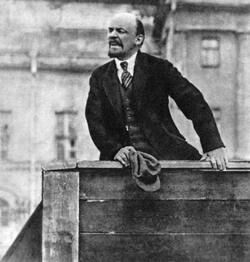Vladimir Ilyich Ulyanov, known as Lenin, was a Russian lawyer, revolutionary, political theorist and statesman. Considered one of the main leaders of the Bolshevik movement, he advocated class struggle and the dictatorship of the proletariat.
In 1917, when the Tsarist regime collapsed, Lenin, then in exile, returned to Russia with German help and seized power. This marked the birth of Soviet Russia, the world's first Communist country. Lenin transformed the country from top to bottom. He instituted censorship of the media, ensuring a monopoly on information. He stripped the bourgeois class and the Church of their possessions, drastically reducing the gap between rich and poor. Using terror to achieve his ends, Lenin created a political police force (the Cheka) whose mandate was to eliminate enemies of the party. He also created the Gulags, forced-labor camps. He nationalized industries and separated church and state. When the peace treaty ending the First World War was signed, he ceded the territory of Ukraine to Germany. The loss of this largely agricultural territory led to famine in Russia. The population reacted strongly to these changes, and soon civil war broke out.
During the war, Lenin was the victim of a shooting attack. His injuries were not fatal, but his health declined rapidly from then on. The civil war ended before his death, and the foundations of Communism were solidified.

-
1870: Vladimir Ilich Ulyanov, known as Lenin, is born on April 22 in Simbirsk, Russia.
-
1917: On March 27, Germany helps Lenin, Trotsky and other exiled Bolshevik revolutionaries to return to Russia. On arrival, Lenin delivers a speech advocating a worldwide socialist revolution.
-
1917: At a meeting of the Bolshevik Party on April 4, Lenin presents his April Theses, in which he sets out his anti-democratic and anti-parliamentary ideas for following up the ongoing revolution.
-
1917: At the end of August, General Lavr Kornilov attempts to overthrow the government, but fails. Nevertheless, he succeeded in weakening the government, making it easier for Lenin to speak.
-
1917: On October 25, on Lenin's orders, the Bolsheviks take control of strategic points in the Russian capital Petrograd.
-
1918: Russia withdraws from the First World War conflict on February 10, ceding the Ukraine to Germany.
-
1918: On the night of July 16-17, Lenin has the former Tsar Nicholas II, his family and other members of the royal family assassinated.
-
1918: The death penalty is reinstated in Russia. The Bolshevik government, led by Lenin, creates the Red Army to contain the many outbreaks of civil war.
-
1918: In response to the assassination attempt on Lenin, the Bolshevik government unleashes the Red Terror. Between 10,000 and 15,000 people are killed in two months. Gulags multiply.
-
1921: A severe famine in Russia leads the Bolshevik government to plunder churches to seize the wealth needed to meet the people's needs. Over eight thousand clergymen opposed to these measures were killed. These measures greatly improved the situation of the people.
-
1922: On December 30, four republics sign a treaty formalizing their union into a single state: the Union of Soviet Socialist Republics (USSR).
-
1924: Lenin died on January 21, in Vishnie Gorki, Russia.
